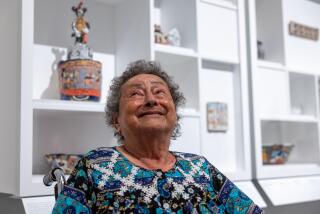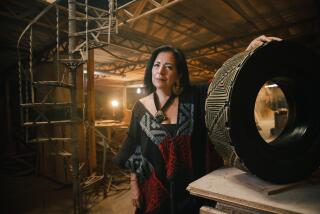Female artists’ surreal visions unfold in LACMA’s ‘In Wonderland’
Almost everyone falls down a rabbit hole sometime in life. A trapdoor opens under your career, your relationships, your beliefs, and headlong you go, like Alice, into the void.
For a few of the 50 female surrealist painters and sculptors represented in LACMA’s exhibition “In Wonderland,” that descent was a terrifying tumble into mental depression, physical danger, even suicidal despair.
But for others it was a subterranean passage to creative fulfillment, erotic liberation and self-discovery, themes that artists such as Frida Kahlo, Leonora Carrington, Lee Miller, Kay Sage, Dorothea Tanning and Remedios Varo visited time and again in their works.
It’s an inspirational theme that the show’s organizers, Ilene Susan Fort, a LACMA curator of American art, and Tere Arcq, former chief curator at the Museo de Arte Moderno in Mexico City, think will resonate with many women, and more than a few men. After all, it did with them.
“This show has changed my life and my feelings about my life, my friendships and family, more than any other show I’ve ever done,” Fort said of the exhibition, on view at LACMA’s Resnick Pavilion through May 6. “And I think it’s because these women make you think and explore inside yourself.”
Spanning the early 1930s to the late ‘60s, “In Wonderland” is being billed as the first major international survey of female surrealists working in the United States and Mexico. Described as “engrossing” by Times art critic Christopher Knight in his review, the show will travel to Quebec and Mexico City after completing its LACMA run. LACMA officials said the show has been popular since its late-January opening, with daily attendance averaging 1,270.
Compared with brand-name male surrealists like Max Ernst and Miguel Covarrubias (some of whom were their husbands and lovers), female surrealists until now have been relatively neglected, exhibited in only a handful of museum shows, mainly solo ones.
The exception, of course, is Kahlo, whose hauntingly graphic, rawly confessional self-portraits were embraced by feminist scholars and spawned a global cult of Frida-mania decades after her death in 1954. But Kahlo’s singular prominence has been a mixed blessing for her female contemporaries. “She did contribute to get attention of women artists overall,” Arcq said. “But at the same time it does overshadow a lot of them.”
Linking Mexico and the United States in one exhibition made sense, the curators said, because many of the artists belonged to social and creative networks that spanned the border. Several knew each other personally; many more had at least a passing familiarity with one another’s work.
A number of the women were European refugees who’d fled the fascist conflagrations in Spain and Nazi-overrun Europe in search of a new start in North America. Particularly for Spanish-speaking outcasts, Mexico proved more welcoming than the United States, which was leery of immigrants with leftist political leanings.
For a number of female surrealists, Mexico — a country of rugged natural beauty and epic history, steeped in indigenous imagery and myths — seemed a land of wonders and a creative playground for Western bohemians estranged from their native cultures. André Breton, the French poet, pamphleteer and surrealist godfather, idealized the earthquake-sculpted nation as a land of “convulsive beauty” — the surrealist country par excellence.
Among female artists who discovered a surrealist mirror in Mexico’s burnished landscapes and matriarchal indigenous societies were Alice Rahon, who joined the surrealists in Paris in 1931 but later moved to Mexico City; Carrington, an England native who fled Europe after her then-lover Ernst was captured and sent to an internment camp (triggering Carrington’s mental breakdown); and Olga Costa, a German who resettled in Mexico and married painter-muralist José Chávez Morado.
Like the topsy-turvy, inverted-logic “wonderland” of Lewis Carroll’s famous story, Mexico and California, where several female surrealists settled, seemed places where the normal art-world rules were made to be broken. They were free-form zones where female artists felt empowered to explore their own fantasies at a comfortable distance from the male art-critical establishment in New York and Europe.
Most of them lived outside conventional marriage. Several took both male and female lovers, and the majority were childless. While their male counterparts were infatuated with Freud, the women were more likely to tap the unconscious through indigenous shamanism, Jungian mythic archetypes and esoteric and occult practices, from the kabbalah and Tarot to Haitian voodoo.
The ideal of self-possession and forging an identity not dependent on male approval was a preoccupation of many female surrealists. In Remedios Varo’s “Woman Departing From the Psychoanalyst’s Office” (1960), a woman shrouded in a green cape steps into a courtyard, removes her self-protective mask and daintily deposits the ghostly head of her white-bearded father down a well.
As Fort notes in her catalog essay: “Men do not appear frequently in the women’s worlds, nor do their sexual fantasies.” Tanning’s “Birthday,” a self-portrait depicting the artist at 30, bare-breasted, with tendrils snaking down her dress as she stands before a labyrinth of doorways, hints at the sense of wide-open possibilities.
One of Kahlo’s best-known paintings, “Las Dos Fridas” (The Two Fridas), anchors a gallery that introduces another of the exhibition’s key motifs: twins and body doubles. Male surrealists typically depicted women as muses and objects of desire. Female surrealists depicted themselves as having complex, dual natures, sometimes represented with animal avatars, or as goddesses and other powerful shamanistic figures.
“They were seeing themselves from inside, while the men were seeing them from outside,” Fort said.
As their works attest, few of these artists led fairy-tale lives. Like Alice’s Wonderland, the world taking shape in the decades before and after World War II was a petrifying place, shadowed by apocalyptic new weapons and shaken by social changes that shattered individual lives.
“A lot of these women had problems,” Fort said. “A lot of them experienced terrible childhoods, or adulthoods. Quite a few of them were depressed or had mood disorders, undiagnosed probably.” At least one of them, Francesca Woodman, committed suicide.
But the influence of the female surrealists continues to seep into the work of later-generation feminist and post-feminist artists like Cindy Sherman.
And the example of artists like Varo and her colleagues, Arcq said, continues to inspire her personally, to pursue everything she wants and “to understand more deeply all the connections between everything that’s happening.”
More to Read
The biggest entertainment stories
Get our big stories about Hollywood, film, television, music, arts, culture and more right in your inbox as soon as they publish.
You may occasionally receive promotional content from the Los Angeles Times.











